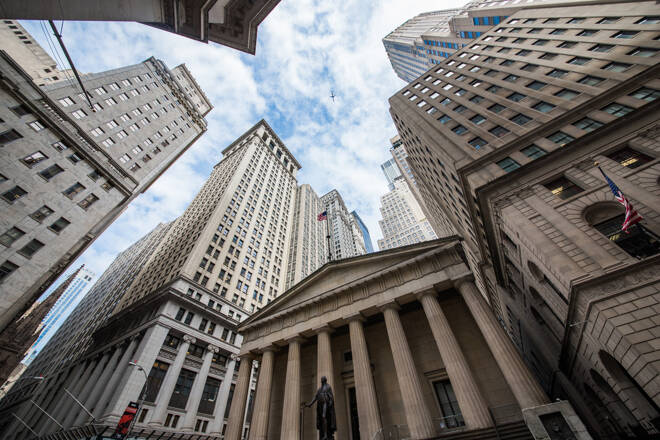Advertisement
Advertisement
Nike Spikes to Record High on Strong Earnings Beat; Buy with Target Price $176
By:
The world’s largest athletic footwear and apparel seller Nike’s shares surged to an all-time high in extended trading on Friday after the company reported better-than-expected earnings in the second quarter and upgraded their full-year sales forecast.
The world’s largest athletic footwear and apparel seller Nike’s shares surged to an all-time high in extended trading on Friday after the company reported better-than-expected earnings in the second quarter and upgraded their full-year sales forecast.
Nike said its revenue increased nearly 9% to $11.24 billion in the second quarter ended November 30, beating analysts’ consensus of $10.56 billion. The footwear company said its profit jumped 12% to $1.25 billion, or 78 cents per share, higher than the Wall Street estimate of 63 cents per share. The company’s digital sales jumped more than 80%.
“We attribute Nike’s ability to navigate the pandemic well to its large owned and third-party e-commerce (now more than 30% of sales), strong demand for athletic gear during the virus, and the global strength of its brand, the source of our wide-moat rating on the firm. We expect to raise our per share fair value estimate of $107 on Nike by a mid-single-digit percentage but rate its shares, which have soared to all-time highs, as overvalued,” said David Swartz, equity analyst at Morningstar.
Following this release, Nike’ shares jumped about 6% to an all-time high of $144.95 in extended trading on Friday; the stock is up over 35% so far this year.
“While Nike’s outlook for the holiday season and the rest of its fiscal year is clouded by the pandemic, its guidance for fiscal 2021 revenue growth in the low teens is in-line with our prior 13% forecast. Moreover, the apparent efficacy of the vaccines provides hope that store disruptions will abate within a few months,” Morningstar’s Swartz added.
Nike Stock Price Forecast
Twenty-eight analysts forecast the average price in 12 months at $151.61 with a high forecast of $174.00 and a low forecast of $115.00. The average price target represents a 10.44% increase from the last price of $137.28. All those 28 analysts, 26 rated “Buy”, two rated “Hold” and none rated “Sell”, according to Tipranks.
Morgan Stanley gave the base target price of $176 with a high of $325 under a bull-case scenario and $85 under the worst-case scenario. The firm currently has an “Overweight” rating on the athletic footwear and apparel company’s stock.
“Reiterate bullish outlook on Nike’s faster 1H21 snapback & mgmt’s accelerated L-T plan. Valuation exceeds historical highs, but out-year revenue forecasts maybe $1-3B+ too low, implying underestimated earnings power. Positive EPS revisions could continue to drive the stock higher; lift PT to $176,” said Kimberly Greenberger, equity analyst at Morgan Stanley.
Several other analysts have also upgraded their stock outlook. Barclays raised the target price to $174 from $150. BTIG upped the stock price forecast to $162 from $152. Jefferies increased the price objective to $140 from $117. Credit Suisse raised the target price to $162 from $160. JP Morgan upped the target price to $170 from $146. Piper Sandler increased the stock price forecast to $168 from $153.
We think it is good to buy at the current level and target $176 as 100-day Moving Average, and 100-200-day MACD Oscillator signals a strong buying opportunity.
Analyst Comments
“Nike is in the early innings of transition from a wholesaler to a DTC brand. Success would make it one of few to benefit from the shift to eComm (~15% of ‘20 sales). Its DTC business (~33% of ‘20 sales) should ignite its next phase of margin-accretive revenue growth, driving a 28%+ 5Y EPS CAGR,” Morgan Stanley’s Kimberly Greenberger added.
“Nike also stands to benefit from advancing global consumer activewear demand (due to the WFH-induced preference for comfort-oriented apparel/footwear and increased focus on health & wellness). Nike’s strategic portfolio decisions, tech investments, and supply chain innovation also creates LT competitive advantages, and are further supported by an industry-leading balance sheet.”
Upside and Downside Risks
Risks to Upside: 1) Faster global activewear market growth. 2) Faster 2H20 wholesale restart. 3) DTC strategy acceleration Market share gains. 4) Supply chain innovation. 5) Sustainable NA segment growth. 6) Better-than-feared COVID-19 impact/potential recession – highlighted by Morgan Stanley.
Risks to Downside: 1) Tariff risk. 2) Competitive risk (ADS). 3) China/international macroeconomic slowdown. 4) NA declines. 5) FX headwinds. 6) ESG mismanagement. 7) Worse-than-feared COVID-19 impact/potential recession.
Check out FX Empire’s earnings calendar
About the Author
Vivek Kumarauthor
Vivek completed his education from the University of Mumbai in Economics and possesses stronghold in writing on stocks, commodities, foreign exchange, and bonds.
Advertisement
